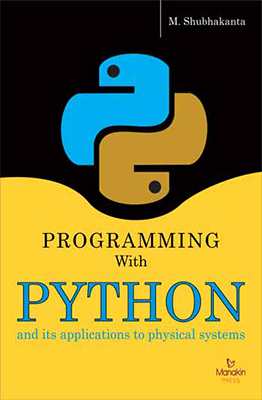Programming with Python and Its Applications to Physical Systems
₹995.00
M. Shubhakanta Singh | Category: Computer Science & ITBook Details
ISBN: 9789384370497
YOP: 2017
Pages: 362
Order also on
This book is an introduction to Python Programming and provides a practical approach to the subject. It is based on the author’s vast experience of teaching Computer Programming and Computational Physics to undergraduate and postgraduate students. The basic concepts of Python are explained in detail and augmented with examples and diagrams to give a thorough understanding of the subject.
The book has been carefully presented so as to be equally attractive and understandable to those new to this language as well as to those without prior knowledge of any programming language. With an aim to consolidate the understanding of the technique, solved problems, both objective and descriptive, have been included. The last chapter explains the application of Python to Natural Sciences. Most of the topics are explained with proper illustrations and related functions/modules are also explained using tables.
1. Introduction
2. Identifiers and Data Types
3. Operators and Expressions
4. Managing Input and Output Operations
5. Decision Making and Branching
6. Decision Making and Looping
7. Functions
8. List
9. Dictionaries
10. Tuples
11. Files
12. Computational Physics– Application in Physical Systems
Appendix I: Objective Type Questions
Appendix II: Descriptive Type Questions
References
Index
This book is an introduction to Python Programming and provides a practical approach to the subject. It is based on the author’s vast experience of teaching Computer Programming and Computational Physics to undergraduate and postgraduate students. The basic concepts of Python are explained in detail and augmented with examples and diagrams to give a thorough understanding of the subject.
The book has been carefully presented so as to be equally attractive and understandable to those new to this language as well as to those without prior knowledge of any programming language. With an aim to consolidate the understanding of the technique, solved problems, both objective and descriptive, have been included.
The last chapter explains the application of Python to Natural Sciences. Most of the topics are explained with proper illustrations and related functions/modules are also explained using tables.
1. Introduction
2. Identifiers and Data Types
3. Operators and Expressions
4. Managing Input and Output Operations
5. Decision Making and Branching
6. Decision Making and Looping
7. Functions
8. List
9. Dictionaries
10. Tuples
11. Files
12. Computational Physics– Application in Physical Systems
Appendix I: Objective Type Questions
Appendix II: Descriptive Type Questions
References
Index
| Weight | 0.705 kg |
|---|---|
| Dimensions | 24 × 16.4 × 2 cm |
| yop |
2017 |
| subject-category |
Computer Science & IT |
| isbn |
9789384370497 |
| binding |
Hardback ,Paperback |




